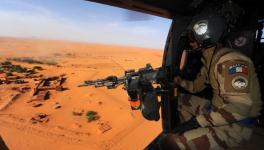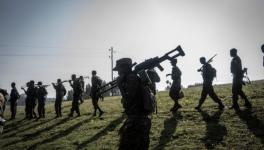Mali's War: The Wages of Sin
The reports filtering out of Northern Mali are appalling: a young couple stoned to death, iconic ancient shrines dismantled, and some 365,000 refugees fleeing beatings and whippings for the slightest violations of Sharia law.
But the bad dream unfolding in this West African country is less the product of a radical version of Islam than a consequence of the West’s scramble for resources on this vast continent, and the wages of sin from the recent Libyan war.
The current crisis gripping northern Mali—an area about the size of France—has its origins in the early years of the Bush administration, when the Untied States declared the Sahara desert a hotbed of “terrorism” and poured arms and Special Forces into the area as part of the Trans-Saharan Counter Terrorism Initiative. But according to anthropologist Jeremy Keenan, who has done extensive fieldwork in Mali and the surrounding area, the “terrorism” label had no basis in fact and was simply designed to “justify the militarization of Africa.”
The U.S. military claimed that when the Taliban fell in Afghanistan, terrorists moved west into the Horn of Africa, Sudan, and the Sahara. But Keenan says “there was absolutely no evidence for that,” dubbing the charge “really a figment of imagination.” The real targets of the enlarged U.S. military footprint were “oil resources” and “the gradually increasing threat of China on the continent.”
The United States currently receives about 18 percent of its energy supplies from Africa, a figure that is slated to rise to 25 percent by 2015. Africa also provides about one-third of China’s energy needs, plus copper, platinum, timber, and iron ore. According to the Financial Times, new gas fields were recently discovered on the Algeria-Mali border.
A Web of Local Conflicts
To be sure, there have been terrorist acts in Africa. In 1998, bombers targeted hotels in Kenya and, in 2002, a synagogue in Tunisia. The 2004 Madrid train bombers were associated with the Moroccan Islamic Combat Group, an organization that set off bombs in Casablanca in 2003.
But these groups had no affiliation with international terror groups like al-Qaeda, and the only one that could be said to be Sahara-based was the Algerian Salafist Group for Fighting and Preaching. That group later renamed itself “Al-Qaeda in the Islamic Maghreb” (AQIM).
In 2006, the International Crisis Group concluded that the Sahara “was not a hotbed of terrorism” and that most North African governments saw the Trans-Saharan Initiative as a way to tap into high-end arms technology like attack helicopters, night vision equipment, and sophisticated communications networks.
When the U.S. African Command (AFRICOM) was formed in 2008, it took over the Initiative and began working directly with countries in the region, including Mali, Morocco, Tunisia, Chad, Niger, Mauritania, and Senegal. Indeed, the only country in the region that did not have a tie to AFRICOM was Libya.
The United States also has basing agreements with Uganda, Ghana, Namibia, Gabon, and Zambia. Some 1,500 U.S. Marines are currently deployed at Lemonier, a French Foreign Legion base in Djibouti on the horn of Africa.
The “terrorism” label has always been a slippery one. For instance, the United States supported the 2006 Ethiopian invasion of Somalia that overthrew the Union of Islamic Courts (UIC) government. Washington said the UIC was associated with al-Qaeda but never produced any evidence. The UIC was a moderate Islamist movement that drove out the U.S.-supported warlords and brought peace to Somalia for the first time since 1991. It included such radical Islamist groups as al-Shabab, but those organizations did not dominate the government.
The Ethiopian invasion changed all that. For Somalians, Ethiopia is a traditional enemy, and al- Shabab succeeded in uniting a large section of the population against the occupation. Thus, a small group that was marginal in the UIC became the backbone of the resistance. “The end result of the US-backed invasion was driving Somalia into the al-Qaeda fold,” says Somalia’s former foreign minister, Ismail Mahmoud Hurre.
The crisis in Mali has a long history rooted in the country’s deep poverty on one hand, and on the other, a push by the Tuaregs—a nomadic Berber people that has long controlled trans-Saharan trade—for greater autonomy and a bigger piece of the development pie. The Tuaregs have staged unsuccessful revolts four times since Mali won its independence from France in 1960, but the fall of Muammar Gaddafi in Libya gave them a golden opportunity.
Gaddafi had long supported the Tuaregs in their war for independence, and many Tuaregs served as pro-government mercenaries in Libya. When Gaddafi fell, a cornucopia of arms opened for the Tuaregs, who quickly put their newly acquired firepower to use against the largely ineffective Malian army.
The so-called “terrorist” groups, like Ansar al-Din, al-Tawhid wa al-Jihad, and AQIM, only moved in after the Tuareg Movement for the National Liberation of Azawad had expelled the Malian army from the north and declared a separate country. It is these groups that are stoning people to death, tearing down Sufi shrines, and enforcing rigid Sharia law. The Tuaregs have largely been pushed to the side, and many of them have returned to the desert, abandoning cities like Timbuktu, Gao, and Kidal to the Islamic groups.
Besides the original protagonists in northern Mali, there is growing tension between the Islamists and the Songhai, Mali’s largest ethnic group. There are rumors that Songhai villages are organizing militias, adding yet another dimension of potential trouble.
None of this had to happen.
When the UN Security Council passed Resolution 1973 on March 17 last year, it was to “protect civilians” in Libya. At the time, the 53-member African Union (AU) was attempting to negotiate a political solution to the crisis, but two days after the UN resolution was approved, NATO launched Operation Odyssey Dawn.
On March 20, the AU met in Mauritania in an effort to stop the fighting. “Our desire,” read a joint AU statement “is that Libya’s unity and territorial integrity be respected as well as the rejection of any kind of foreign intervention.” The AU was acutely aware that Africa’s delicate post-colonial borders have enormous potential for creating instability, and that Libya might end up being a falling domino.
“Whatever the motivation of the principal NATO belligerents [in ousting Gaddafi], the law of unintended consequences is exacting a heavy toll on Mali today,” former UN regional envoy Robert Fowler told the Guardian, “and will continue to do so throughout the Sahel as the vast store of Libyan weapons spreads across this, one of the most unstable regions of the world.”
A decade of growing U.S. military involvement on the continent has not only failed to curb instability and the growth of so-called “terrorist” groups; the United States’ actions in Somalia and Libya have directly fed the formation of such organizations. And “training” foreign militaries has hardly stabilized things. Indeed, Amadou Sanogo, the Malian army captain who overthrew the civilian government in the wake of the Tuareg offensive, was trained by the U.S. military. Sanogo attended the Defense Language Institute in 2005 and 2007, a U.S. Army intelligence program in 2008, and an officer-training course in 2010.
Forecast: Blowback
“Terrorism” in Africa is fueled by local conditions, not by an international jihadist agenda. Boko Haram in Nigeria reflects the tension between the country’s largely poverty-stricken Islamic north and its more prosperous Christian south. Similar fault lines run through Niger, Ivory Coast, and Cameroon. Terrorism in Algeria and Morocco mirrors economies that are unable to provide jobs for a huge swath of their populations, coupled with authoritarian political structures that stifle any attempt to do something about it. Somalia was first a pawn in the Cold War, and then the very definition of chaos. When an Islamist government began taming that chaos, the United States overthrew it, unleashing al-Shabab.
Hundreds of millions of dollars in aid is being directed at fighting terrorism on the continent, and the U.S. military is training the armed forces of dozens of African nations. A Malian army captain used that aid and training to pull off a coup that now threatens to turn into a regional war.
Will Morocco use U.S. aid to fight terrorism or instead tighten its grip over the mineral-rich Western Sahara and re-ignite its war with the Polisario Front? Will Niger fight “terrorists” or crush Tuareg resistance to French uranium mining in the Sahara? Will Algeria go after the AQIM or its own outlawed Islamist organizations? Will aid to fight terrorism in Nigeria be diverted to smash resistance by local people to oil production in the Niger Delta?
Bayonets won’t defeat the source of terrorism and instability in Africa. Indeed, military solutions tend to act as recruiting sergeants for groups like AQIM. Africa doesn’t need more weapons—it needs aid, development, and programs that lift a significant section of the continent’s population out of poverty.
Get the latest reports & analysis with people's perspective on Protests, movements & deep analytical videos, discussions of the current affairs in your Telegram app. Subscribe to NewsClick's Telegram channel & get Real-Time updates on stories, as they get published on our website.
























